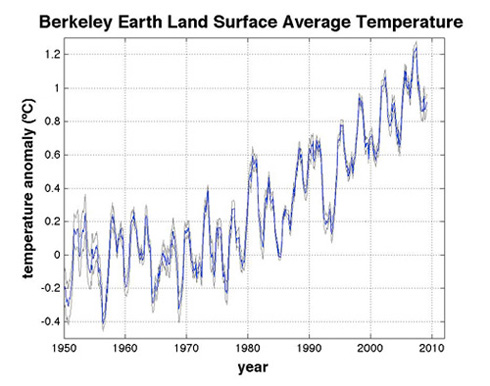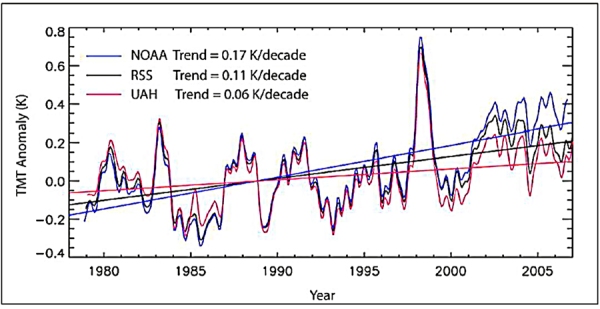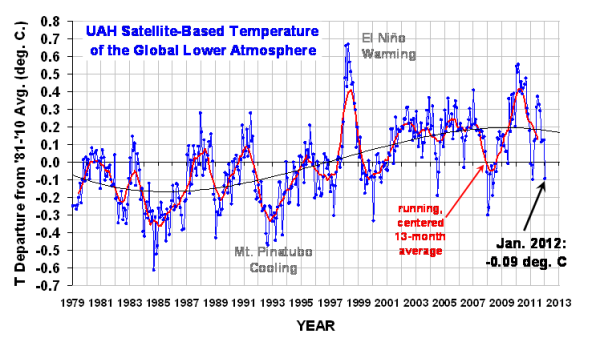3 FEBRUARY 2012
Summary: This is the second in a series of posts examining what we know about global temperature trends. The first discussed the strong consensus about the warming of the past two centuries. This post shows the consensus about the stabilization of global temperatures during the past decade (roughly). Both sides of the public debate (among laymen) try to obscure these simple facts in order to advance their own interests.
Chapters in this series
- What we know about our past climate, and its causes
- What we know about the present climate
- Forecasts and causes of future climate
- What we’re learning about climate, and recommendations
Contents of this post
This post shows the statements about recent global temperature trends by a few of the many experts working on climate science issues. They represent a broad range of perspectives in the climate science field. Jones and Hanson are mainstream figures; Whitehouse is a skeptic; the Berkeley project is a new attempt to resolves some of these issues. Also shown is the satellite record, left to speak for itself.
- Phil Jones, director of the Climate Research Unit at UEA
- James Hanson, NASA
- David Whitehouse of the Global Warming Policy Foundation
- The Berkeley Earth Surface Temperature project
- Global Sea Surface temperatures
- The satellite record
- For more information: other posts about climate science
(1) “Q&A: Professor Phil Jones“, BBC, 13 February 2010 –BBC’s environment analyst Roger Harrabin interviews Phil Jones, director of the Climatic Research Unit (CRU) at the University of East Anglia (UEA).
Question: Do you agree that from 1995 to the present there has been no statistically-significant global warmingDr. Jones: Yes, but only just. I also calculated the trend for the period 1995 to 2009. This trend (0.12C per decade) is positive, but not significant at the 95% significance level. The positive trend is quite close to the significance level. Achieving statistical significance in scientific terms is much more likely for longer periods, and much less likely for shorter periods.Question: Do you agree that from January 2002 to the present there has been statistically significant global cooling?Dr. Jones: No. This period is even shorter than 1995-2009. The trend this time is negative (-0.12C per decade), but this trend is not statistically significant.
(2) “Global Temperature in 2011, Trends, and Prospects“, James Hansen et al, NASA’s Goddard Institute for Space Sciences, 18 January 2012

Thus, although the current global warming graphs (Figs. 2, 3 and the upper part of Fig. 7) are suggestive of a slowdown in global warming, this apparent slowdown may largely disappear as a few more years of data are added. In particular we need to see how high global temperature rises in response to the next El Niño, and we also need to consider the effect of the 10-12 year cycle of solar irradiance. This raises the question of when the next El Niño will occur and the status of the solar cycle.
(3) David Whitehouse (former Science correspondence of the BBC, PhD Astrophysics from U Manchester), Global Warming Policy Foundation, 31 December 2011 (red emphasis added):
It showed no increase in temperature. It has been often stated that there has been no statistically significant warming in the various temperature datasets since the start of this century, and this is now generally accepted. Pushing it back a few more years is possible. The years 1999 and 2000 were slightly cooler than the post-2001 data but since 1998, a strong El Nino year, is higher they provide compensation for each other. Thus if you look at the trend since 1997 you can easily see, and calculate, that it is negligible.It is also possible to push it back a few more years still, according to the brief calculations made by Prof Phil Jones. It seems that 1995 – 2009 is flat, but 1995 – 2010 has a slight positive trend, though not at any impressive significance. It should be noted that 1995 – 2011 is back to no significant increase.Statistically speaking it is accurate to say that according to HadCrut3 the world’s temperature has not increased for the 16 years between 1995 and 2011, though many prefer the more conservative ten years post-2001. This is not a ‘sceptical’ claim just a straightforward description of the data.… The world has warmed since the start of the current warming spell that started around 1980 and each decade has been warmer than the previous one. … It is curious that the small data set of the recent warming spell (only thirty numbers or so if annual data is used) has been argued about, analysed and misrepresented for so long by climatologists and activists.
(4) The Berkeley Earth Surface Temperature project, from the Frequently Asked Questions page of their website. (red emphasis added)
Has Global Warming Stopped?Some people have suggested that there has been no global warming over the past 13 years, and they ask whether our land-only analysis verifies that. The graph shows the results of our analysis with 1-year averaging (to smooth it) for the last 6 decades so you can better see the period in question. The blue curve is the result of our analysis, and the grey lines represent our 95% confidence limit.
The large fluctuations up and down that take place every few years correlate very strongly with the North Atlantic temperatures (the AMO index) and with El Nino (ENSO index 3.4). See our paper on “Decadal Variations in the Global Atmospheric Land Temperatures” for analysis of that. The presence of these fluctuations makes any strong extrapolations from short-term behavior uncertain.Some people draw a line segment covering the period 1998 to 2010 and argue that we confirm no temperature change in that period. However, if you did that same exercise back in 1995, and drew a horizontal line through the data for 1980 to 1995, you might have falsely concluded that global warming had stopped back then. This exercise simply shows that the decadal fluctuations are too large to allow us to make decisive conclusions about long term trends based on close examination of periods as short as 13 to 15 years.Do Judith Curry and Richard Muller disagree?Below is a joint statement by Judith Curry (Professor and Chair of the School of Earth and Atmospheric Sciences at the Georgia Institute of Technology ) and Richard Muller (Prof of Physics at Berkeley):In recent days, statements we’ve made to the media and on blogs have been characterized as contradictory. They are not.We have both said that the global temperature record of the last 13 years shows evidence suggesting that the warming has slowed. Our new analysis of the land-based data neither confirms nor denies this contention. If you look at our new land temperature estimates, you can see a flattening of the rise, or a continuation of the rise, depending on the statistical approach you take.Continued global warming “skepticism” is a proper and a necessary part of the scientific process. The Wall St. Journal Op-Ed by one of us (Muller) seemed to take the opposite view with its title and subtitle: “The Case Against Global-Warming Skepticism — There were good reasons for doubt, until now.” But those words were not written by Muller. The title and the subtitle of the submitted Op-Ed were “Cooling the Warming Debate – Are you a global warming skeptic? If not, perhaps you should be. Let me explain why.” The title and subtitle were changed by the editors without consulting or seeking permission from the author. Readers are encouraged to ignore the title and read the content of the Op-Ed.We do not agree with each other on every feature of climate change. We have had vigorous discussions, for example, on the proper way to analyze hurricane records. Such disagreements are an essential part of the scientific process.
(5) Global Sea Surface temperatures (SST)
The temperature datasets that get the most attention measure land surface temperatures. Not only are the seas 70% of the Earth’s surface, but the oceans are the primary reservoir of heat for the coupled sea-air system in which we live. Unfortunately we don’t have good historical data (for this purpose) before roughly 1982. There are several datasets of accurate global SST data after the earlly 1980s; for details see Bob Tisdale’s “An Overview Of Sea Surface Temperature Datasets Used In Global Temperature Products“.
Here is a graph of NOAA Sea Surface Temperature data from Bob Tisdale’s website, which combines both direct measurements (ie, ships and buoys) and satellite data) Again, no warming this decade. SST’s show the effect of the large decadal-scale cycles (eg, La Nina – El Nino in the tropical Pacific), which effect global temperatures.
The Argo project, a net work of high-tech buoys fully deployed in 2007, now provides high quality data of global ocean temperatures at various depths. This will answer many questions about climate dynamics, and allow development of better modesls. For more information see:
(6) The satellite temperature record
Satellite data is often described by non-experts as the definitive source of global temperatures.
For more about satellite climate data see this article by the National Institute of Standards and Technology (NIST), 6 February 2012
Satellites do not measure temperature directly; instead they measure the amount of radiation incident on their sensors at various key wavelengths and sometimes polarizations associated with different meteorological phenomena and different sections of the atmosphere or surface. Those data are then processed by different groups using various methods to yield temperature equivalents.
It gets even more complex. Adjustments must be made for sensor decay, change of satellite orbits, and replacement of satellites.
There are three major datasets: the National Oceanic and Atmospheric Administration (NOAA), Remote Sensing Systems (RSS, data from NASA satellites), and the University of Alabama at Huntsville (UAH). This graph from the NIST article shows the recent temperature plateau.
Here is the UAH data through January 2012 (source: Roy Spencer, co-developer of the data series)
(6) Other early articles noting the stabilization of global temperatures
- “What happened to global warming?“, BBC, 9 October 2009
- “World will ‘cool for the next decade’“, New Scientist, 9 September 2009 — Summary of forecasts about decadal cooling (e.g., “Advancing decadal-scale climate prediction in the North Atlantic sector“, Mojib Latif et al, Nature, 1 May 2008
- “Climatologists Baffled by Global Warming Time-Out“, Der Spiegel, 19 November 2009
- “World may not be warming, say scientists“, The Times, 14 February 2010
(5) For more information: other posts about climate science
(a) For more information see the other FM Reference Pages:
- Science and Nature – my articles.
- Science & nature – studies & reports
- Science & Nature – general media articles
- Articles from the 1970′s about global cooling/warming
Posts about melting polar ice and rising sea levels:
- An example of important climate change research hidden, lest it spoil the media’s narrative, 22 May 2009
- About that melting arctic ice cap, 17 April 2010
- Fear or Fail: about the melting Greenland ice sheet, 24 May 2010
- Today’s good news, about rising sea levels, 3 June 2010 — Esp note the links to articles and studies!
- It’s time to worry (again) about disappearing arctic ice, 8 June 2010
- Climate Armageddon postponed (again): the melting polar ice, 9 October 2010
- Looking into the past for guidance about warnings of future climate apocalypses, 17 October 2010








No comments:
Post a Comment